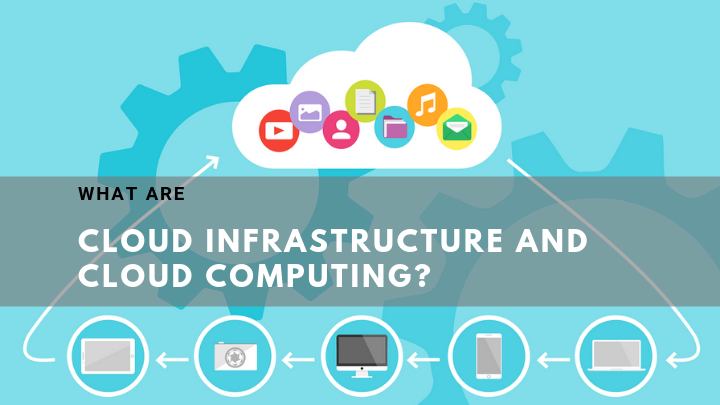
Check out the detailed case study article regarding cloud infrastructure and cloud computing and how they are closely related with SaaS (Software as a Service).
Cloud computing and infrastructure are concepts that have been at the forefront of the tech industry for a long time. In fact, tech experts consider it one of the basic knowledge that they should acquire in pursuit of expertise in the tech field. As expected, however, lots of people are yet to get proper meaning of it. In this article, we’ve provided all the initial explanations you need as cloud infrastructure and cloud computing basics.
It will also be great if you learn more advanced knowledge from various online cloud computing courses. Consider it as basic level of cloud computing tutorial.
What is Cloud Infrastructure and Cloud Computing architecture?
In very simple terms, meaning of cloud infrastructure management is the complete delivery of computer services – including storage, servers, networking, databases, analytics, software, and intelligence over the internet in a bid to offer flexible resources, faster innovation, and better economies of scale. As it stands, you are basically paying for just the cloud services being used and this helps for the reduction of operating costs, as well as for efficient running of infrastructure.
Cloud computing is basically divided in three categories.
- SaaS (Software as a Service)
- IaaS (Infrastructure as a Service)
- PaaS (Platform as a Service)
Advantages and examples of Cloud Infrastructure and Cloud Computing architecture
Since its invention, cloud infrastructure services has brought about a shift in the way businesses understand and think about IT resources. Here, take a look at seven top benefits that are making organizations look the way of cloud infrastructure and become part of cloud computing companies.
1. Cost reduction
Cloud infrastructure reduces cost by eliminating the capital expenses involved in the purchase of software and hardware as well as that involved in the setting up of on-site data centers – this includes the rack of servers, the IT expertise for cloud infrastructure management as well as the round-the-clock electricity for power.
Take a look at all the cost that is being cut off and it will make sense to you why organizations are pursuing it.
2. Speed
One of the biggest positives for cloud infrastructure is the option for speed that it provides for users. Most cloud infrastructure and cloud computing services are provided on demand as self-service, so no matter the number of computing resources required, you can be assured that it will and be provided in a very short time, typically with as little as a few clicks of the mouse, providing businesses with a good level of flexibility.
3. Global scale
Nothing beats knowing that you have the ability to tap into resources from across borders to scale your business. One of the biggest benefits of cloud infrastructure is the ability it provides for a business to be able to scale elastically. This simply means that the business would get the right amount of IT resources irrespective of where they will be sourced from.
4. Productivity
Most times, on-site data centers require a very large amount of racking and stacking, which can be time-consuming. For businesses like an online class help, some things like; setting up hardware, patching of software, and other IT management chores can take lots of time to be completed. With cloud computing, however, the need for most of these tasks is removed, so instead of spending lots of time on setups, tech teams can focus their time on the achievement of other important business goals.
5. Reliability
With cloud computing and infrastructure solutions, data recovery, data backup, and business continuity become easier and less costly than it would have traditionally been because data can now be tailored from redundant sites to more productive sites on the cloud network.
6. Performance
One of the biggest benefits for cloud infrastructure management is its special attention to performance. The biggest cloud infrastructure services are run on a secure worldwide network of data centers, with particular attention paid to consistent upgrading to the latest generation of quick and efficient hardware. This comes with its own tons of benefits over the use of a single data center.
7. Security
Most cloud infrastructure solutions consists a wide set of technologies, policies, and control, all combining to strengthen overall security, so that apps, data, and infrastructure are protected from potential threats.

Different types of Cloud Infrastructure and Cloud Computing services
Despite being encompassing in its definition, cloud infrastructure services still comes in different types and the different types are designed for use by different people. Several different types, models, and services have evolved over time, with knowledge of each designed to help offer different solutions for different people.
Cloud computing companies choose the model, as per their need and level of operations. As an example, Animation and VFX studio will consider to opt Foundry Athera, which is a cloud computing technology to control entire post production pipeline on Google Cloud Platform.
If you would work with cloud infrastructure, then you have to first determine the specific cloud computing architecture that you intend your cloud services to be implemented upon. Typically, there are three distinct deployments of cloud computing services including private cloud, public cloud, and hybrid cloud. Check out their distinct characteristics and meanings.
1. Private cloud
A private cloud basically refers to the combination of cloud infrastructure resources used by just one organization or business. The private cloud of a business is normally either located on the company’s on-site data center or at a physical location. We’ve also seen some companies task a third-party service provider to help them host their private cloud.
In simple terms, a private cloud refers to a cloud where services and infrastructure are maintained on a private network.
2. Public cloud
Public cloud, on the other hand, is almost a direct opposite of private cloud explained above. In this case, the clouds are owned and serviced by a third-party service provider, which is charged with the delivery of computer resources like storage and servers, over the internet.
A popular example of public cloud is Microsoft Azure. In the case of a public cloud usage, all software, hardware, and supporting infrastructures are owned and controlled by a cloud provider. A business would be able to access the services with the use of a web browser and can hire microsoft certified azure data scientist associate whose service will help the business to grow.
3. Hybrid cloud
If you guessed that this one involves the combination of the two listed above, then you are absolutely right. Hybrid clouds are a combination of the features of private clouds and that of public clouds, with the help of a technology that allows sharing of data and application. This type of cloud offers more flexibility to businesses that use them by allowing them to be able to move comfortably across public and private clouds.
Services of cloud infrastructure and cloud computing are encompassing terms that offers quite a lot. Considering its benefits, it is not surprising that a lot of businesses are already adopting its usage to grow their reach both locally and across borders. Getting an AWS certification can help you learn more about cloud infrastructure and how the concept can help you scale your business.
Online cloud computing courses helps a lot to learn right knowledge. Internet is filled up with tons of cloud computing tutorials and ppt. For the same, the author is well equipped with relevant resources to make online learning easier and better. Register for a course now.
